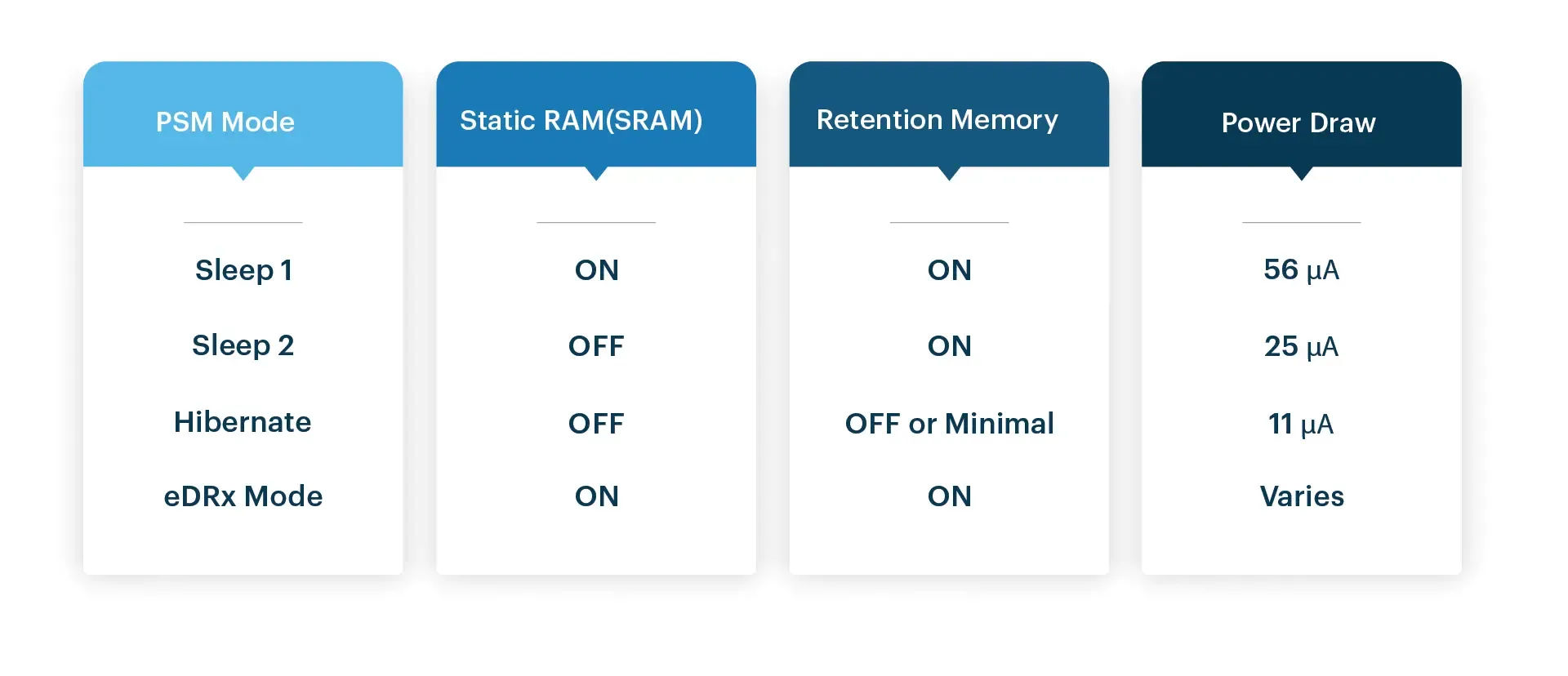Batteries run everything in this modern world of technological marvels. From a simple time-keeping watch to smart homes and personal devices all the way to Electric Vehicles, efficient battery management is crucial for ensuring performance, safety, and longevity. As these systems become increasingly sophisticated and interconnected, the need for robust and power-efficient cellular IoT solutions to manage and maximize their efficiency has never been greater.
This is where the LTE Cat 1bis network technology shines and modules like the C16QS that utilize these networks are stepping up to revolutionize smart connected battery management solutions. In this blog, we dive deep into details of different network technologies that are commonly used to enable Smart BMS Solutions, their bandwidth capabilities and how they uniquely complement thi specific use case.
The Challenge: Balancing Performance and Power Efficiency in Connected BMS
Traditional battery management systems relied on wired connections or short-range wireless technologies, limiting their scalability and real-time monitoring capabilities. Cellular IoT has emerged as a compelling solution, offering widespread coverage, reliability, and remote access to critical battery data. However, achieving a harmonious balance between data throughput, low power consumption, and cost-effectiveness has remained a persistent challenge. Consider these key aspects:
Data Demands
Modern BMS require sufficient data rates to transmit vital information like voltage, current, temperature, and State-of-Charge (SoC) for real-time analysis and control.
Power Constraints
Battery Management Systems, especially in remote or mobile settings, demand extremely low power consumption to ensure that the process of managing itself does not draw too much power from the battery.
Final BOM
For widespread adoption, cellular IoT modules need to be cost-effective without compromising on either performance or reliability.
Meet the Competition in Low Power Connectivity
TLow Power Wide Area Networks are a category of network technologies that were introduced by GSMA in 2015, to drive the adoption of LPWA solutions using licensed spectrum. This initiative focused on two key 3GPP standards: LTE-M and NB-IoT. These two network technologies were realized as part of 3GPP release 13, offering a licensed spectrum tailored for long range and remote IoT deployments.
While both operate within licensed spectrum and offer advantages for IoT deployments, they exhibit unique performance characteristics:
LTE-M
Prioritizes higher throughput(upto 1Mbps in downlink and uplink) and lower latency, making it well-suited for latency-sensitive applications. This performance profile comes with a trade-off, typically requiring higher current consumption, potentially impacting battery life compared to NB-IoT.
NB-IoT
Designed for maximum energy efficiency, extended battery life and greater coverage, NB-IoT is ideal for static or infrequently communicating devices. NB-IoT's speeds are very low compared to other network technologies(upto 26Kbps in downlink and 66Kbps in uplink)but positions itself as a compelling choice for applications demanding battery life spans of up to a decade or more.
If the application was a Agricultural monitoring system, that would only send data about soil temperature, humidity, water levels etc. on a cyclical basis, NB-IoT would be the optimal choice as the lower throughput would cause no significant consequence but the extended range and device lifespan would be extremely beneficial.
Consider if the application was a gas-pipeline monitoring system with a host of sensors that would relay data about flow rate, vibrations/haptic values, pressure, temperature, seismic values. Such data would require a higher refresh rate, as anomalies must be identified as fast as possible. Thereby, LTE-M would be a more snug fit for this particular use case.
Yet there exists unique applications like the Battery management system of an electric vehicle that requires the higher bandwidth as offered by LTE-M but must also work seamlessly within a power constrained environment as NB-IoT based devices would.
One could say LTE Cat 1bis as a network technology can overcome the hurdles faced in such specific use cases, wherein the existing strict power draw constraints must not hinder the module's network bandwidth.
Introducing the C16QS: A Gateway for Smart BMS
The Cavli C16QS cellular IoT module, built on the robust LTE Cat 1bis technology, is engineered to address the specific challenges of low power cellular connectivity that can also deliver respectable network bandwidths. Combining LTE Cat 1-esque data speeds with exceptional power efficiency, the C16QS empowers OEMs to develop next-generation BMS that excel in performance, longevity, and cost-effectiveness.
Cat 1 Performance at Reduced Complexity
The C16QS delivers higher data rates (up to 10 Mbps downlink), providing ample bandwidth for real-time battery data transmission, enabling more data bandwidths to be used for collecting sensory data.
Extended Battery Life with Power Saving Modes
The C16QS incorporates advanced power-saving features, including:

Sleep 1
Enables rapid transition to low-power idle state, while the module is ready to wake up as and when needed.
Sleep 2
Minimizes power consumption during extended periods of inactivity, with a focus on network latching.

Hibernate
It is the lowest power consumption state the module can achieve, with current consumption values that fall into the low micro-Ampere range.

eDRx
Stands for extended Discontinuous Reception, it significantly reduces power consumption by allowing the module to sleep for longer intervals while remaining registered on the network.
Empowering OEMs to Build Smarter BMS

The C16QS module provides OEMs with comprehensive power saving modes for developing cutting-edge connected BMS, offering numerous advantages:
Sleep 1 (56 µA): Prioritized Data Retention
Target Scenario
Situations where preserving both compute and network status is essential for seamless operation resumption, even at the cost of slightly higher power consumption. Example: A sensor node within the BMS that needs to quickly resume data collection and transmission upon waking up.
Memory Management
Static Memory (SRAM)
Remains powered ON to preserve application state, variables, and sensor data.
Retention Memory
Also ON, retaining critical system settings, network configurations, and potentially a small amount of recent sensor readings.
Resume Behavior
The system powers up from Sleep 1 relatively quickly, as both compute and network states are retained. The application can pick up where it left off, restoring variables and resuming tasks without needing full re-initialization.
Sleep 2 (25 µA): Faster Latching with Network Focus
Target Scenario
If a faster wake-up and network reconnection are prioritized over retaining full compute state, this is the optimal sleep mode to use. Example: If the BMS needs to quickly re-establish a network connection to transmit current battery charge levels or charge state.
Memory Management
Static Memory (SRAM)
Powered OFF to reduce power consumption.
Retention Memory
Remains ON, specifically storing essential network configurations (credentials, connection parameters) to enable rapid network latching upon wake-up.
Resume Behavior
The system wakes up faster than Sleep 1 due to the SRAM power-down. The application needs to perform a fresh boot, but network reconnection is significantly faster.
Hibernate (11 µA): Ultra-Low Power for Basic Boot
Target Scenario
Situations where minimizing power consumption is paramount, and retaining previous state information is not critical. Example: If the BMS is powered at low battery state, and communication to remote terminal as a requirement is yet to be determined.
Memory Management
Static Memory (SRAM)
Powered OFF.
Retention Memory
Either OFF or only retaining the absolute bare minimum data (e.g., boot code) required for a basic boot process.
Resume Behavior
The system takes the longest to boot up, as it needs to reload everything from non-volatile memory. No prior compute or detailed network state is preserved. This mode offers the lowest possible power consumption, ideal for extremely long battery life requirements.
eDRx Mode: Configurable & Cyclical Network Sleep
Target Scenario
Situations where the module must be ready to transmit data, but it has to happen at pre-defined and customizable cyclical intervals, thereby lengthening the battery life. Example: The BMS solution of a remote monitoring device is configured to send device charge levels and usage at an interval of 30 minutes.
Memory Management
Static Memory (SRAM)
Remains powered ON to preserve application state, variables, and sensor data.
Retention Memory
Also ON, retaining critical system settings, network configurations, and potentially a small amount of recent sensor readings.
Resume Behavior
The system is partially asleep as far as the network is considered, only able to receive data until the preset interval time. Once the timer runs out, the module becomes visible to the network by starting a paging window, ready to send or receive required data. The process is repeated as per the configurable interval.
Delivering a Seamless Experience for End-Users
The benefits of integrating the C16QS module extend beyond OEMs, directly enhancing the end-user experience:
Consider a scenario where a user has deployed multiple monitoring devices across a remote landscape that keeps a keen eye on weather conditions for agricultural purposes, The Battery Management System within the device uses a C16QS module , configured to use PSM modes like eDRx, Sleep and hibernate to conserve charge levels until each battery swap cycle which is at an interval of 15 days.

Under nominal conditions, the module would be programmed to work in eDRx state, wake up at intervals of 30 minutes, and send relevant weather data like ambient temperature, humidity, soil moisture levels etc. If an unprecedented event on the fifth day prompts adverse weather conditions, the user would reprogram the module to wake up every 10 minutes to ensure the adverse weather conditions do not affect crop yield.
Say the adverse conditions last 8 hours, and since the module was waking up every 10 minutes during the event, the remaining charge levels would not be sufficient to sustain 10 more days of normal operability. The user could then easily utilize either of the sleep states and set longer eDRx wake intervals to triage the remaining battery charge levels. If adverse weather conditions return and charge levels drop even further, the module can be dropped into hibernate mode to extend the battery even further to ensure uninterrupted operability till the next battery swap.

Closing Notes
The C16QS module represents a significant step forward in cellular IoT for connected BMS. Its unique combination of LTE Cat 1bis performance, advanced power management, and cost-effectiveness makes it the ideal solution for BMS applications that are constrained by power draw, ushering in a new era of intelligent and sustainable battery management.
Feel free to write to us at solutions@cavliwireless.com or visit the product page directly with the link below.


